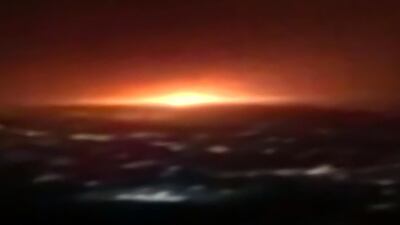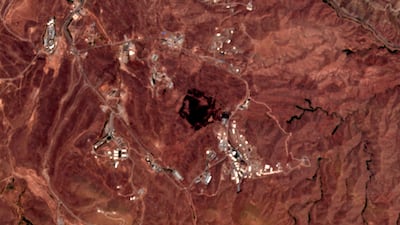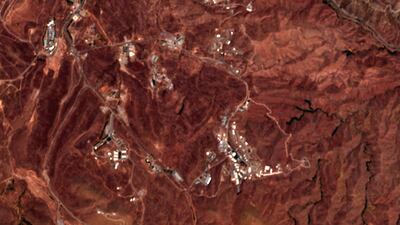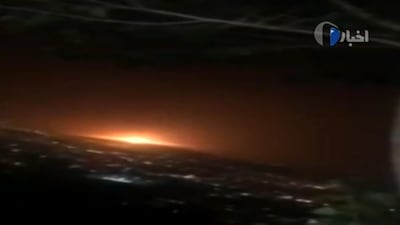Days after a late-night explosion at a missile production site outside Tehran, another blast on Thursday struck what appears to be a centrifuge production plant at Iran’s Natanz nuclear enrichment centre.
The Atomic Energy Organisation of Iran sought to play down the fire, calling it an “incident” that only affected an under-construction “industrial shed", spokesman Behrouz Kamalvandi said.
But he and Iran’s nuclear chief, Ali Akbar Salehi, rushed to the scene of the fire at the high-security underground enrichment centre.
A photograph later released by the agency showed a brick building with scorch marks and its roof apparently destroyed.
It was not clear if that was the “shed” to which Mr Kamalvandi referred.
Debris on the ground and a door that seemed to have been blown off its hinges showed an explosion accompanied the blaze.
It would not be the first time the site, which was one of those visited by international weapons inspectors, was be the target of sabotage.
Before the fire was reported, journalists at BBC Persian said they received a tip-off from a group calling themselves the Cheetahs of the Homeland claiming responsibility for an "operation" targeting "newly established" production facilities at the nuclear site.
The group said it struck buildings above ground so that the attack would be undeniable.
Cheetahs of the Homeland, which claims to be dissident members of Tehran's security forces, is new to Iran experts and the BBC said it could not authenticate the claim.
Data collected by a US National Oceanic and Atmospheric Administration satellite suggested the fire broke out about 2am local time in the north-west corner of the Natanz compound.
The blaze was bright enough to be detected by the satellite.
Mr Kamalvandi told Iranian state television that the fire caused only material damage and that work at the site is unaffected.
Fabian Hinz, of the James Martin Centre for Nonproliferation Studies at the Middlebury Institute, California, said the site was in the same spot as a newly opened centrifuge production facility.
Mr Hinz said he relied on satellite images and a state-TV programme on the centre to find the building, which is in Natanz’s north-west corner.
David Albright, of the Institute for Science and International Security, also said the fire struck the production plant.
Mr Albright's institute wrote a report on the new plant, identifying it from satellite pictures while it was being built and later completed.
Centrifuges rapidly spin uranium hexafluoride gas to enrich uranium.
The International Atomic Energy Agency says Iran enriches uranium to about 4.5 per cent purity.
That is above the terms of a nuclear deal signed between Tehran and world powers in 2015, but far below weapons-grade levels of 90 per cent.
It has also conducted tests on advanced centrifuges, the IAEA says.
Natanz, 250 kilometres south of Tehran, is a centre for enriching uranium.
It includes a warren of underground facilities buried under 7.6 metres of concrete to protect them from air strikes.
Natanz is of particular concern to Tehran as it has been sabotaged before.
The Stuxnet computer virus disrupted and destroyed centrifuges at Natanz amid the height of western concerns over Iran’s nuclear programme.
Satellite photos show an explosion last Friday that rattled Iran’s capital came from an area in its eastern mountains that analysts believe hides an underground tunnel system and missile production sites.
Iran has blamed the blast on a gas leak in a “public area.”
Another explosion from a gas leak at a medical clinic in northern Tehran killed 19 people Tuesday.
President Donald Trump withdrew the US from the nuclear deal in May 2018, setting up months of tension between Tehran and Washington.
Iran is now breaking all production limits set by the deal but still allows IAEA inspectors and cameras to watch its nuclear sites.
















